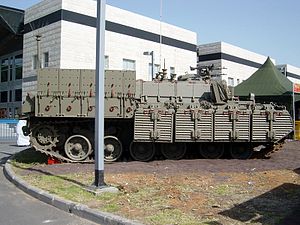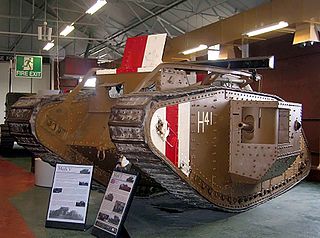
An armoured fighting vehicle or armored fighting vehicle (AFV) is an armed combat vehicle protected by armour, generally combining operational mobility with offensive and defensive capabilities. AFVs can be wheeled or tracked. Examples of AFVs are tanks, armoured cars, assault guns, self-propelled artilleries, infantry fighting vehicles (IFV), and armoured personnel carriers (APC).

The M113 is a fully tracked armored personnel carrier (APC) that was developed and produced by the FMC Corporation. The M113 was sent to United States Army Europe in 1961 to replace the mechanized infantry's M59 APCs. The M113 was first used in combat in April 1962 after the United States provided the South Vietnamese army (ARVN) with heavy weaponry such as the M113, under the Military Assistance Command, Vietnam (MACV) program. Eventually, the M113 was the most widely used armored vehicle of the U.S. Army in the Vietnam War and was used to break through heavy thickets in the midst of the jungle to attack and overrun enemy positions. It was largely known as an "APC" or an "ACAV" by the allied forces.
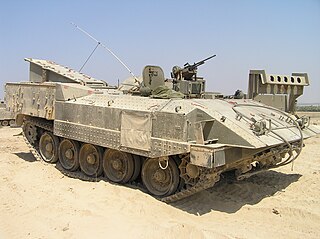
The Achzarit is a heavily armored personnel carrier manufactured by the Israeli Defence Forces Corps of Ordnance.

The Véhicule de l'Avant Blindé or VAB is a French armoured personnel carrier and support vehicle designed and manufactured by Renault Trucks Defense. It entered French service in 1979 and around 5,000 were produced for the French Army as well as for export. It has seen combat in various conflicts in Africa, Asia as well as Europe and has also been exported to more than 15 countries.
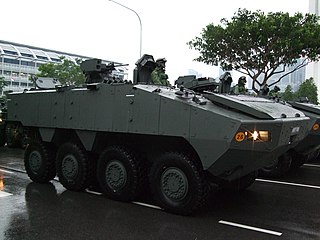
The Terrex Infantry Carrier Vehicle (ICV) is an armoured fighting vehicle (AFV) developed by ST Engineering of Singapore and Timoney Technology of Ireland, and produced by ST Engineering Land Systems for the Singapore Army as well as by Turkish auto-maker Otokar as the Yavuz (AV-82) for the Turkish military.

A Kangaroo was a Canadian armoured personnel carrier (APC) during the Second World War which was created by converting a tank chassis. Kangaroos were created as an expedient measure "in the field" by the Canadian Army, and were so successful that they were used by other Commonwealth forces, including the British Army.

The BRDM-1 is a Soviet amphibious armored scout car. It was the first purpose-built Soviet reconnaissance vehicle to enter service since the BA-64 and was built on the chassis and drive train of the BTR-40 armored personnel carrier. It is the world's first mass-produced combat vehicle of its class.

The Israeli Infantry Corps is a corps in the Israel Defense Forces. It is a maneuvering corps which primarily relies on infantry troops. It includes several regular and reserve service units and brigades which are operationally commanded by the IDF's regional commands.

Nagmachon is a heavily armoured infantry fighting vehicle fielded by the Israel Defense Forces. The Nagmachon evolved from the NagmaSho't armoured personnel carrier (APC), which in turn was based on Centurion tank Sho't hulls from the 1970s and 1980s. The vehicle carries thick belly armour designed to withstand mine-blasts and mountings on the front hull for various engineering devices such as mine plows, mine rollers and bulldozer blades. With its belly armour and the relatively heavy armour of the Centurion hull, the Nagmachon also carries explosive reactive armour to counter high-explosive anti-tank (HEAT) shaped charge rounds, such as rocket propelled grenade (RPG) RPG-7s.
A huge number of M113 armored personnel carrier variants have been created, ranging from infantry carriers to nuclear missile carriers. The M113 armored personnel carrier has become one of the most prolific armored vehicles of the second half of the 20th century, and continues to serve with armies around the world in many roles.

The BTR-T was a Russian heavy APC, designed by the Design Bureau of Transport Machine-Building (Omsktransmash) state-run production association.

The Dragoon 300 AFV was produced by Arrowpointe Corporation during the 1980s. It was based on the automotive components of the United States Army's M113 APCs and 5-ton trucks. It resembles a larger V-150 Commando.

Sho't is the Israeli designation of the 105mm L7 armed modified Centurion tank, which entered Israeli service in the 1960's.
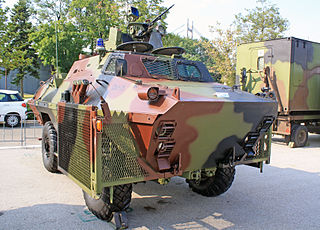
The BOV, is an all-wheel drive armoured vehicle manufactured in the former Yugoslavia and today in Serbia. The second generation BOV is currently in development.
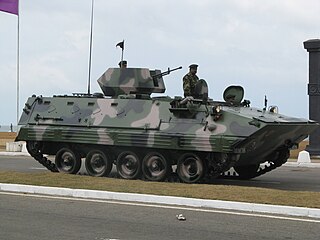
The Norinco Type 89 tracked armoured fighting vehicle is a Chinese armoured personnel carrier. It was developed from the earlier export market Type 85 AFV vehicle. It entered service in the late 1990s and was first shown publicly in 1999. There are approximately 1,000 in service. It has the industrial index of WZ534 and although it was mainly developed for the PLA, there is also an export version YW534.

An armoured personnel carrier (APC) is a broad type of armoured military vehicle designed to transport personnel and equipment in combat zones. Since World War I, APCs have become a very common piece of military equipment around the world.

Namer is an Israeli armoured personnel carrier based on a Merkava Mark IV tank chassis. Namer was developed by and is being assembled by the Israeli Ordnance Corps. It has entered service in limited numbers with the Israel Defense Forces since the end of 2008. Due to budgetary constraints, the introduction of the Namer into the IDF has been slow, leaving the ground forces dependent on the M113 until 2027.

The M2 Bradley, or Bradley IFV, is an American infantry fighting vehicle that is a member of the Bradley Fighting Vehicle family. It is manufactured by BAE Systems Land & Armaments and entered service in 1981, with fielding beginning in 1983.
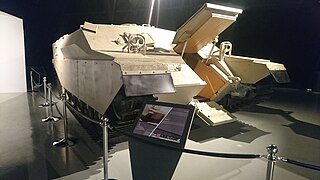
Dawsar or MAP II is a heavily armored personnel carrier developed by King Abdullah Design and Development Bureau. It is based on Tariq main battle tank, an upgraded version of Centurion. The Jordanian Army received four of these vehicles in 2014.
The Light Armoured Vehicle (LAV) is a series of armoured vehicles built by General Dynamics Land Systems – Canada (GDLS-C), a London, Ontario-based subsidiary of General Dynamics. It is a license-produced version of the Mowag Piranha. The first generation of LAV was created by Mowag for the Armoured Vehicle General Purpose (AVGP) requirement of the Canadian Army. This was a 6x6 variant of the Piranha I produced by General Motors Diesel in London, Ontario. Since entering service in 1976, it has undergone a number of upgrades. The LAV II introduced the now-familiar 8x8 configuration. The LAV continues to form the backbone of the Canadian Army's combat vehicle fleet. The LAV series of vehicles exist in a number of different variants and are used in a number of different roles such as armoured personnel carriers, engineering vehicles, command posts, ambulances and armoured recovery vehicles.
